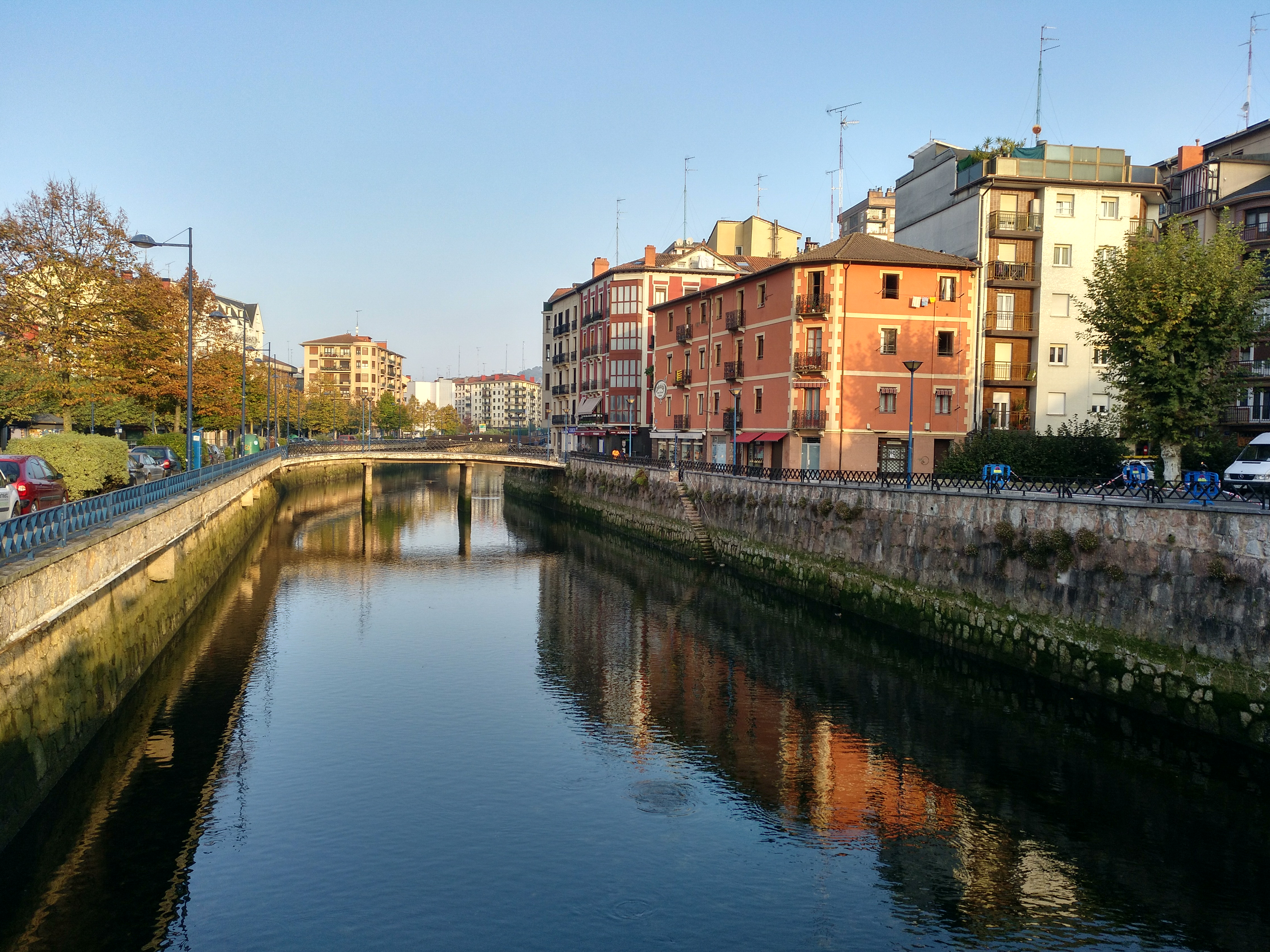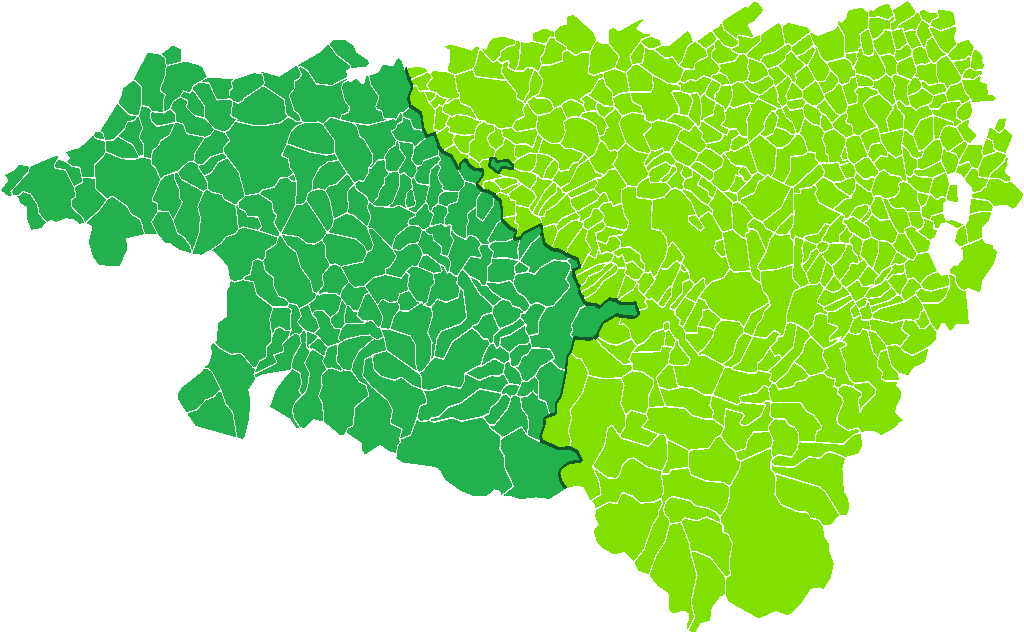|
Gipuzkoa, Basque Country
Gipuzkoa (, , ; es, Guipúzcoa ; french: Guipuscoa) is a province of Spain and a historical territory of the autonomous community of the Basque Country. Its capital city is Donostia-San Sebastián. Gipuzkoa shares borders with the French department of Pyrénées-Atlantiques at the northeast, with the province and autonomous community of Navarre at east, Biscay at west, Álava at southwest and the Bay of Biscay to its north. It is located at the easternmost extreme of the Cantabric Sea, in the Bay of Biscay. It has of coast land. With a total area of , Gipuzkoa is the smallest province of Spain. The province has 89 municipalities and a population of 720,592 inhabitants (2018), from which more than half live in the Donostia-San Sebastián metropolitan area. Apart from the capital, other important cities are Irun, Errenteria, Zarautz, Mondragón, Eibar, Hondarribia, Oñati, Tolosa, Beasain and Pasaia. The oceanic climate gives the province an intense green colour with little ... [...More Info...] [...Related Items...] OR: [Wikipedia] [Google] [Baidu] |
Provinces Of Spain
A province in Spain * es, provincias, ; sing. ''provincia'') * Basque (, sing. ''probintzia''. * Catalan (), sing. ''província''. * Galician (), sing. ''provincia''. is a territorial division defined as a collection of municipalities, although their origin dates back to 1833 with a similar predecessor from 1822 (during the Trienio Liberal) and with roots in the Napoleonic division of Spain into 84 prefectures in 1810. In addition to their political function, provinces are commonly used today as geographical references for example to disambiguate small towns whose names occur frequently throughout Spain. There are many other groupings of municipalities that comprise the local government of Spain. The boundaries of provinces can only be altered by the Spanish Parliament, giving rise to the common view that the 17 autonomous communities are ''subdivided'' into 50 provinces. In reality the system is not hierarchical but defined according to jurisdiction ( es, compet ... [...More Info...] [...Related Items...] OR: [Wikipedia] [Google] [Baidu] |
Pyrénées-Atlantiques
Pyrénées-Atlantiques (; Gascon Occitan: ''Pirenèus Atlantics''; eu, Pirinio Atlantiarrak or ) is a department in the southwest corner of France and of the region of Nouvelle-Aquitaine. Named after the Pyrenees mountain range and the Atlantic Ocean, it covers the French Basque Country and the Béarn. Its prefecture is Pau. In 2019, it had a population of 682,621.Populations légales 2019: 64 Pyrénées-Atlantiques INSEE History Originally named Basses-Pyrénées, it is one of the first 83 created during the |
Hondarribia
Hondarribia ( eu, Hondarribia; es, Fuenterrabía; french: Fontarrabie) is a town situated on the west shore of Bidasoa river's mouth, in Gipuzkoa, in Basque Country (autonomous community), Basque Country, Spain. The border town is situated on a little promontory facing Hendaye (France) over the Txingudi bay. A service boat makes the trip between the two cities. The town holds an ancient old quarter with walls and a castle. In addition, Hondarribia features a beach across the Bidasoa from the touristy housing estate ''Sokoburu'' in Hendaye, alongside a mountain called Jaizkibel providing a hilly backdrop to the town. A road leads north-east from the beach area to the Cape Higuer, located in this municipality. The town harbours the San Sebastian Airport, which serves domestic flights. The population as of 2005 is 15,700 inhabitants. Battles The battles fought for possession of this fortified stronghold are generally known by the Spanish name for the place (Fuenterrabía). * Unsucc ... [...More Info...] [...Related Items...] OR: [Wikipedia] [Google] [Baidu] |
Eibar
Eibar ( eu, Eibar, es, Éibar) is a city and municipality within the province of Gipuzkoa, in the Basque Country of Spain. It is the head town of Debabarrena, one of the '' eskualde / comarca'' of Gipuzkoa. Eibar has 27,138 inhabitants ( Eustat, 2018). Its chief industry is metal manufacturing, and has been known since the 16th century for the manufacture of armaments, particularly finely engraved small arms. It was also the home of Serveta scooters. It is home to the SD Eibar football team. Geography Eibar lies at an altitude of 121m above sea level, in the west of the province of Gipuzkoa, right next to Biscay. Eibar has an oceanic climate. The town lies in a narrow valley in a mountainous area, the highest mountains are between 700 and 800 metres high. Eibar is traversed by river Ego, which is a tributary of the Deba. Apart from the urban area, the municipality consists of five rural neighbourhoods: Otaola-Kinarraga, Aginaga, Arrate, Mandiola and Gorosta. History The c ... [...More Info...] [...Related Items...] OR: [Wikipedia] [Google] [Baidu] |
Mondragón
Mondragón ( eu, Arrasate or ''Mondragoe''), officially known as Arrasate/Mondragón, is a town and municipality in Gipuzkoa Province, Basque Country, Spain. Its population in 2015 was 21,933. Economic and historical significance The town is best known as the birthplace of the Mondragon Corporation, the world's largest worker cooperative, whose foundation was inspired in the 1940s by the Catholic priest José María Arizmendiarrieta. In 2002 the MCC contributed 3.7% to the total GDP of the Basque Country and 7.6% to the industrial GDP. The valley of the High Deba where the town is located enjoyed a high level of employment in the 1980s while the rest of the Basque industrial areas suffered from the steel crisis. Noted poverty expert and sociology professor Barbara J. Peters of Stony Brook Southampton has studied the incorporated and entirely resident-owned town of Mondragón. "In Mondragón, I saw no signs of poverty. I saw no signs of extreme wealth," Peters said. "I saw pe ... [...More Info...] [...Related Items...] OR: [Wikipedia] [Google] [Baidu] |
Zarautz
Zarautz (, es, Zarauz) is a coastal town located in central Gipuzkoa, Basque Country, in Spain. It is bordered by Aia to the east and the south and Getaria to the west, located about west of San Sebastián. It has four enclaves limiting the aforementioned municipalities: Alkortiaga, Ekano, Sola, and Arbestain. , Zarautz has a population of 22,890, which usually swells to about 60,000 in the summer. The Palace of Narros, located adjacent to Zarautz's long beach, is where Queen Isabella II and Fabiola of Belgium once spent their summer holidays. The beach is known for being the longest in the Basque Country and one of longest of the Cantabrian cornice. The Mayor of Zarautz since 2015 has been Xabier Txurruka (Basque Nationalist Party). History *1237: The site is founded as a town and its Navarrese charters confirmed by king Fernando III of Castile. *1857: The beginning of the Industrial Revolution in Zarautz, thanks to the enterprise "Fabril Linera". An era of economic growth ... [...More Info...] [...Related Items...] OR: [Wikipedia] [Google] [Baidu] |
Errenteria
Errenteria ( eu, Errenteria/Orereta, es, Rentería) is a town located in the province of Gipuzkoa in the Basque Autonomous Community, in the north of Spain, near the French border. The river Oiartzun cuts its way through the town, one that has undergone severe pollution up to recent times on its lower stage. History The town was founded in 1320, during the reign of Alfonso XI of Castile, with the name of ''Villanueva de Oiarso'' or ''Oyarço''. It soon started to be known as ''La Rentería''http://www.errenteria.net/es/ficheros/41_10745es.pdf Rentería a Inicios de la Edad Moderna (1495-1544). Iago Irijoa Cortés, David Martín Sánchez because it hosted the office where iron export taxes were collected (taxes were called ''rentas reales'' i.e. royal rents in medieval Castile). The Basque form ''Errenteria'' (also ''Errenteri'' o ''Errenderi'') started to appear towards the end of the 16th century. In 1998, the town hall decided to use ''Errenteria'' as the only official ... [...More Info...] [...Related Items...] OR: [Wikipedia] [Google] [Baidu] |
Irun
Irun ( es, Irún, eu, Irun) is a town of the Bidasoaldea region in the province of Gipuzkoa in the Basque Country (autonomous community), Basque Autonomous Community, Spain. History It lies on the foundations of the ancient Oiasso, cited as a Ancient Rome, Roman-Vascones, Vasconic town. During the Spanish Civil War, the city was site of the 1936 Battle of Irun, which ended with a strategic victory for the Nationalist faction (Spanish Civil War), Nationalist forces. Location and transport One of the biggest towns in Gipuzkoa, its location on the France–Spain border, border between Spain and France, across the Bidasoa river from Hendaye), has made Irun into a commercial and logistic centre. Irun railway station is a major break-of-gauge where the SNCF Rail tracks, rails meet the broad gauge Renfe ones. Currently Irun has a fairground with a modern exhibition and telecommunication facilities, just some 100 metres away from the actual border at the Santiago Bridge (river Bi ... [...More Info...] [...Related Items...] OR: [Wikipedia] [Google] [Baidu] |
Municipalities Of Spain
The municipality ( es, municipio, , ca, municipi, gl, concello, eu, udalerria, ast, conceyu)In other languages of Spain: * Catalan/Valencian (), sing. ''municipi''. * Galician () or (), sing. ''municipio''/''bisbarra''. *Basque (), sing. ''udalerria''. * Asturian (), sing. ''conceyu''. is the basic local administrative division in Spain together with the province. Organisation Each municipality forms part of a province which in turn forms part or the whole of an autonomous community (17 in total plus Ceuta and Melilla): some autonomous communities also group municipalities into entities known as ''comarcas'' (districts) or ''mancomunidades'' (commonwealths). There are a total of 8,131 municipalities in Spain, including the autonomous cities of Ceuta and Melilla. In the Principality of Asturias, municipalities are officially named ''concejos'' (councils). The average population of a municipality is about 5,300, but this figure masks a huge range: the most populo ... [...More Info...] [...Related Items...] OR: [Wikipedia] [Google] [Baidu] |
Cantabric Sea
The Cantabrian Sea; french: Mer Cantabrique, gl, Mar Cantábrico, ast, Mar Cantábricu, eu, Kantauri. is the term used mostly in Spain to describe the coastal sea of the Atlantic Ocean that borders the northern coast of Spain and the southwest side of the Atlantic coast of France. It extends from the cape Estaca de Bares in the province of A Coruña, to the mouth of the river Adour, near the city of Bayonne on the coast of the department of Pyrénées-Atlantiques in French Basque Country. The sea borders of coastline shared by the Spanish provinces of A Coruña, Lugo, Asturias, Cantabria, Biscay and Gipuzkoa Gipuzkoa (, , ; es, Guipúzcoa ; french: Guipuscoa) is a province of Spain and a historical territory of the autonomous community of the Basque Country. Its capital city is Donostia-San Sebastián. Gipuzkoa shares borders with the French depa ..., and the French area of Labourd. Notes and references {{notelist European seas Seas of Spain Seas of France Mar ... [...More Info...] [...Related Items...] OR: [Wikipedia] [Google] [Baidu] |
Bay Of Biscay
The Bay of Biscay (), known in Spain as the Gulf of Biscay ( es, Golfo de Vizcaya, eu, Bizkaiko Golkoa), and in France and some border regions as the Gulf of Gascony (french: Golfe de Gascogne, oc, Golf de Gasconha, br, Pleg-mor Gwaskogn), is a gulf of the northeast Atlantic Ocean located south of the Celtic Sea. It lies along the western coast of France from Point Penmarc'h to the Spanish border, and the northern coast of Spain west to Cape Ortegal. The south area of the Bay of Biscay that washes over the northern coast of Spain is known locally as the Cantabrian Sea. The average depth is and the greatest depth is . Name The Bay of Biscay is named (for English speakers) after Biscay on the northern Spanish coast, probably standing for the western Basque districts (''Biscay'' up to the early 19th century). Its name in other languages is: * ast, Mar Cantábricu * eu, Bizkaiko golkoa * br, pleg-mor Gwaskogn * french: golfe de Gascogne (named after Gascony, France) * gl, ... [...More Info...] [...Related Items...] OR: [Wikipedia] [Google] [Baidu] |



.jpg)